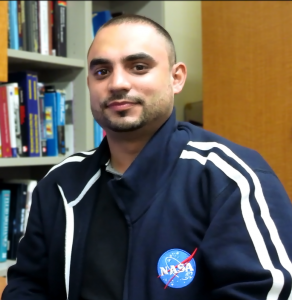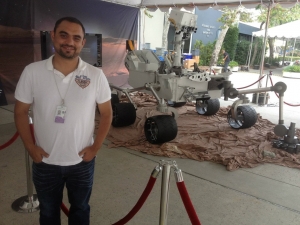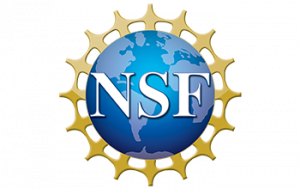Ph.D. in Mechanical Engineering
Research: Previous studies by Lebassi et al. (2009) analyzed summer surface June, July and August mean-monthly maximum air temperature trends between 1950-2005 for two California air basins: San Francisco Bay Area and South Coast Air Basin. The spatial distribution of the observed summer max temperatures showed a complex pattern in which cooling trends were found at low elevation coastal areas open to marine air penetration and warming trends at inland and high elevation coastal areas. The authors suggested that increased sea breeze activity was responsible for the observed coastal cooling. The current research focuses on the extreme monthly-average maximum air temperatures for the all of California to determine both the spatial variability of this effect and the most influential factors on coastal cooling.
Statistical analyses identify coastal cooling as far as 60 km from the coast and below 500 m MSL, consistent with the sea-breeze causal hypothesis. Cross-sections verify these assumptions, since the intensity of the cooling signal decreases significantly when inland-distance increases. In addition, two new coastal-cooling air basins were detected: San Luis Obispo Air Basin and San Diego Air Basin.
The high correlation of summer coastal and inland maximum temperatures with Pacific Decadal Oscillation (PDO) magnitude suggests that the summer coastal cooling could be modulated by this signal. Two factors exist that could induce the increased pressure gradient that generates the increased sea breeze activity: the temperature increases of inland areas, (a consequence of large-scale warming) and the cooling of SSTs (controlled by the PDO). Which mechanism has a stronger influence on coastal cooling is still unknown.
Internship: June 18th- August 23rd, 2013 as a JPL Minority Student Summer Fellow, NASA Jet Propulsion Laboratory, Pasadena, CA
The spatial distribution of the observed summer max temperatures in the LA area shows a complex pattern in which a 40 year cooling trend was found in low-elevation coastal areas open to marine air penetration and warming trends in inland and high elevation coastal areas. Analyses of hourly surface meteorological data from 18 meteorological stations in the Los Angeles area during last summer indicate that the maximum pressure and temperature gradients in the area occurs at late afternoon hours, this drives onshore winds that reaches their maximum at the same time. To better understand this phenomenom, these previous stations, along with 5 wind profilers in the area are going to be used as ground support during the August 2013 AVIRIS and MASTER flight campaigns. New high resolution Land Cover-Land Use, surface albedos and surface temperatures will be the products of this campaign as inputs to upcoming atmosphere and energy modeling studies. Building on the research developed by the JPL/CCNY team over the past few years, the ultimate goal of this project is to use HyspIRI preparatory data in to develop new remote sensing-based tools for assessing the impact of urban environments on complex coastal cities, focusing in weather, climate and energy demand trends.
Bio: Currently a PhD Candidate in Mechanical Engineering at the City College of New York. Graduated Cum-Laude from the Universidad Simon Bolivar in Caracas, Venezuela in Geophysics Engineering and also on a Masters in Statistics from the same university. His research interests include: long-term temperature and precipitation trend analysis, evaluation of societal impacts on climate change, linkage between climate and energy consumption trends, environmental statistics, Bayesian statistics and multivariate spatial statistical analysis.
Conferences : He’s participated as main author in many conferences such as the American Meteorological Society Conference, ASME International Conference on Energy Sustainability and the TIES Conference of the Environmentrics Society. Awards include Best Paper in the ASME 6th Energy Sustainability Conference for the paper: “Energy Demand Projections in the 21st Century for Coastal California ” and Bronze Medal in the National Mathematics Olympics in Venezuela.
Publications:
- GONZALEZ CRUZ, J., P. SEQUERA, Y. MOLINA, R. PICON, J. PILLICH, A. T. GHEBRRGZIABHER and B. BORNSTEIN, 2013: “Climate and Energy vulnerability in Coastal Regions: The Case for US Pacific and Northeast Corridor Coastal Regions. Climate Vulnerability: Understanding and Addressing Threats to Essential Resources. Elsevier Inc., Academic Press, 3-35 pp. ISBN: 9780123847034.
- SEQUERA, P., MOLINA, Y., GONZALEZ, J.E., BORNSTEIN, R., and LEBASSI, B., 2012: “Energy Demand Projections in the 21st Century for Coastal California ”, 6th International Conference on Energy Sustainability. Technical Publication: ESFuelCell2012-91243. Awarded Best Paper in the Conference.
- SEQUERA, P., MOLINA, Y., GONZALEZ, J.E., BORNSTEIN, R., and LEBASSI, B., 2012: “Energy Demand Projections in the 21st Century for Coastal California ”, Journal of Solar Engineering (In review).
- SEQUERA, P., GHEBREEGZIABHER, A., GONZALEZ, J.E., BORNSTEIN, R., and LEBASSI, B., 20123: “Detection of Global Warming Reverse-Reaction Coastal Cooling along the California Coast”, Journal of Climate (In review)
- SEQUERA, P., RHONE, O., GONZALEZ, J.E., BORNSTEIN, R., and LEBASSI, B., 2011: “Impacts of Climate Changes in the Northern Pacific Coast on Related Regional Scale Energy Demands”, 5th International Conference on Energy Sustainability. Technical Publication: ESFuelCell2011-54482.
- SEQUERA, P. and GUENNI, L., 2009 “Evaluación de la Dependencia Entre Variables Macroclimáticas y la Precipitación de Venezuela Utilizando Modelos Log-lineales y Cópulas”. Memoirs of the 6th Colombia-Venezuela Statistical Meeting. Topic: Environmental and Industrial statistics.
- DÍAZ, M., ALDANA, M., JIMÉNEZ, S.M., SEQUERA, P. and COSTANZO-ALVAREZ, V., 2006 “EPR and EOM Studies in Well Samples From Some Venezuelan Oil Fields: Correlation With Magnetic Authigenesis”. Revista Mexicana de Fisica. Vol. 52, Supl. 3.




